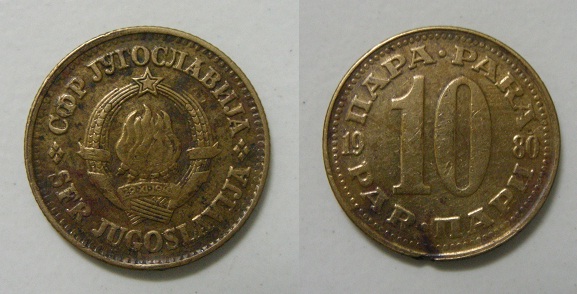Until 1992 Yugoslavia was know as Socialist Federal Republic of Yugoslavia which consisted of 6 republics. They are:
- Socialist Republic of Bosnia and Herzegovina
- Socialist Republic of Croatia
- Socialist Republic of Macedonia
- Socialist Republic of Montenegro
- Socialist Republic of Serbia
- Socialist Republic of Slovenia.
 |
| Emblem of SFR Yugoslavia |
The emblem of Yugoslavia featured six torches, surrounded by wheat with a red star at its top, and burning together in one flame; this represented the brotherhood and unity of the six federal republics mentioned above; forming Yugoslavia.
The date imprinted is 29 November 1943 - on this date the Anti-Fascist Council of National Liberation of Yugoslavia (AVNOJ) met in Jajce on its second meeting and formed the basis for post-war organisation of the country, establishing a federal republic (this date was celebrated as Republic Day after World War II).
In 1992, Four of the six republics declared independence and issued their own currencies shortly after.
From 1966 to 1994, 5 revaluations of the Yugoslavian Dinar took place.
1966-1989 Hard dinar: (100 Para = 1 Dinar)
On January 1,1966, the first of five revaluations of the currency took place, at a ratio of 100 to 1. In the late 1980s the inflation rate accelerated, causing the currency to be revalued at the beginning of 1990.
 |
| 5 Dinar |
Years: 1982-1986
Metal: Nickel-brass
Metal: Nickel-brass
 |
| 2 Dinar |
Years: 1982-1986
Metal: Nickel-brass
Metal: Nickel-brass
 |
| 1 Dinar |
Years: 1973-1981
Metal: Copper-nickel-zinc
Metal: Copper-nickel-zinc
 |
| 20 Para |
Years: 1965-1981
Metal: Brass
Metal: Brass
 |
| 10 Para |
Years: 1965-1981
Metal: Brass
Metal: Brass
1990-1992 Convertible Dinar: (100 Para = 1 Dinar)
The second revaluation took place on January 1, 1990, at a ratio of 10,000 to 1. During this period, the constituent republics began to leave the Socialist Federal Republic of Yugoslavia. Four of the six republics declared independence and issued their own currencies shortly after. This was the last dinar that bore the coat of arms and the name of the "Socialist Federal Republic of Yugoslavia" in multiple languages.
The second revaluation took place on January 1, 1990, at a ratio of 10,000 to 1. During this period, the constituent republics began to leave the Socialist Federal Republic of Yugoslavia. Four of the six republics declared independence and issued their own currencies shortly after. This was the last dinar that bore the coat of arms and the name of the "Socialist Federal Republic of Yugoslavia" in multiple languages.
 |
| 50 Para |
Years: 1990-1991
Metal: Copper-zinc
Metal: Copper-zinc
 |
| 10 Para |
Years: 1990-1991
Metal: Copper-zinc
Metal: Copper-zinc
1992-1993 Reformed Dinar:The third revaluation took place on July 1, 1992, at a ratio of 10 to 1. Hyperinflation began to occur during this currency's period of circulation. This dinar was issued in the then Federal Republic of Yugoslavia, which consisted of the remaining republics of Serbia and Montenegro. (This federation split in 2006 and Montenegro currently uses the Euro as its currency, though it does not mint it.)
1993 October Dinar:
1993 October Dinar:
The fourth revaluation took place on October 1, 1993, at a ratio of 1 million to 1. This revaluation did not interrupt the hyperinflation and the currency lasted a mere three months.
1994 January Dinar:
The fifth revaluation took place on January 1, 1994, at a ratio of 1 billion (109) to 1. This currency suffered from the worst hyperinflation of all the dinar and was replaced within one month.
The fifth revaluation took place on January 1, 1994, at a ratio of 1 billion (109) to 1. This currency suffered from the worst hyperinflation of all the dinar and was replaced within one month.
1994-2003 Novi Dinar: (100 Para = 1 Dinar)
On January 24, 1994, the novi dinar (nominative plural: novi dinari; novi means new) was introduced.The "novi" portion of the name was abandoned in 2000.
 |
| 1 Novi Dinar |
Years: 1994-1995
Metal: Copper-nickel-zinc
Metal: Copper-nickel-zinc
Here are all the coins together.

===XX===
No comments:
Post a Comment